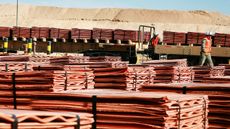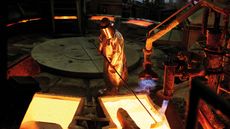Metal prices could be set to bounce back – here’s how to profit
Metal prices have been battered, and with them mining stocks. But they could both be about to bounce back. Dr Matthew Partridge explains why.


Life has been tough for miners lately.
Metal prices just keep falling. Copper and lead are both down by around 20% since July. Aluminium is down 10% since September. And the price of iron ore has more than halved since its peak.
As a result, mining and commodity-related shares have dived too. Glencore is down 25% in the last four months. And mining giant Rio Tinto is down 20% from its 2014 peak.
Subscribe to MoneyWeek
Subscribe to MoneyWeek today and get your first six magazine issues absolutely FREE

Sign up to Money Morning
Don't miss the latest investment and personal finances news, market analysis, plus money-saving tips with our free twice-daily newsletter
Don't miss the latest investment and personal finances news, market analysis, plus money-saving tips with our free twice-daily newsletter
But there could be light at the end of the tunnel. And that could make now a good time to hunt for mining sector bargains.
Why money printing could boost commodity prices
One is the slowing economy in China. The second is the end of quantitative easing (QE) in the US. And the third is simple oversupply high prices drove miners to back ever more marginal projects and dig ever more metal out of the ground.
China's prospects don't look likely to change soon. But the other two negatives might not be quite as powerful as they used to be.
The US might have ended QE, but Europe has just embarked on it. The European Central Bank (ECB) is printing money to buy bonds each month. QE doesn't encourage banks to lend it just buys them time while they repair their balance sheets. Instead, the printed money largely finds its way into financial markets.
And while European shares will likely be among the first to benefit from Mario Draghi's largesse, at least some of this money printing is likely to spill out into the commodity markets too.
What's more, there also signs that lower prices are starting to affect supply. During the boom of the past few years, even marginal projects found it easy to get funding. But this has gone into reverse.
Companies have been reducing their spending on exploring and setting up new mines. Some are even mothballing entire mines. For example, Glencore has cut production by 50,000 tons from a copper mine in Argentina. Rio Tinto has also reduced output at one in the US by 100,000 tons. The biggest single cut comes from BHP Billiton's copper mine in Chile, which is the largest in the world.
And it's not just copper of course. One of the largest lead mines in the world has been forced to shut down too. In fact, so many mines are closing or slashing production that some analysts who had been predicting a large oversupply now think that this won't happen after all.
Two miners to play a potential rebound
So how should you play this?
The simplest way to bet on rebounding base metals prices is to invest into one of the large mining companies whose shares have been hit by the recent plunge in prices. These mining stocks may have further to fall, but they are also large enough to ride out the boom-and-bust cycle without collapsing.
While many of the major miners look attractive, one I'd highlight is Anglo American Mining (LSE: AAL). Anglo mines a range of base metals, from copper to nickel, so it isn't dominated by the fortunes of just one commodity.
The company currently trades at a 28% discount to the value of its net assets. While this is likely to narrow as a result of falling metals prices, it still represents quite a significant margin of safety. It also pays a dividend yield of 5%, which the firm should be able to support by delaying future investment.
The company is also making strong progress in cutting costs, with total costs down by 7% across the group in the past six months or so. Most of its operations are in either South Africa or Latin America. As a result, it should benefit from a stronger dollar because its income from sales of commodities is in dollars, while its costs are in weaker local currencies.
If you're feeling like more of a punt, then a purer play on metals is Freeport-McMoRan Inc (NYSE:FCX), which gets around half its revenue from copper, with the rest coming from gold and oil. The dividend yield is 7% the sort of level that suggests the market is sceptical about its ability to maintain it but earnings should be helped by a decision last year to hedge around 80% of this year's oil production before the crash.
Matthew graduated from the University of Durham in 2004; he then gained an MSc, followed by a PhD at the London School of Economics.
He has previously written for a wide range of publications, including the Guardian and the Economist, and also helped to run a newsletter on terrorism. He has spent time at Lehman Brothers, Citigroup and the consultancy Lombard Street Research.
Matthew is the author of Superinvestors: Lessons from the greatest investors in history, published by Harriman House, which has been translated into several languages. His second book, Investing Explained: The Accessible Guide to Building an Investment Portfolio, is published by Kogan Page.
As senior writer, he writes the shares and politics & economics pages, as well as weekly Blowing It and Great Frauds in History columns He also writes a fortnightly reviews page and trading tips, as well as regular cover stories and multi-page investment focus features.
Follow Matthew on Twitter: @DrMatthewPartri
-
 Private school fees soar and VAT threat looms – what does it mean for you?
Private school fees soar and VAT threat looms – what does it mean for you?Rising private school fees could see more than one in five parents pull their children out of their current school. Before you remortgage, move house or look to grandparents for help, here’s what you need to know.
By Katie Williams Published
-
 Best and worst UK banks for online banking revealed
Best and worst UK banks for online banking revealedWhen it comes to keeping your money safe, not all banks are equal. We reveal the best and worst banks for online banking when it comes to protecting your money from scams
By Oojal Dhanjal Published
-
 These 2 stocks are set to soar
These 2 stocks are set to soarTips The returns from these two aluminium and tin stocks could be spectacular when the commodity cycle turns says David J Stevenson.
By David J Stevenson Published
-
 A lesson for investors from a ill-fated silver mine
A lesson for investors from a ill-fated silver mineAnalysis Mining methods may have changed since the industry’s early days, but the business hasn’t – digging ore from the ground and selling it at a profit. The trouble is, says Dominic Frisby, the scams haven't changed either.
By Dominic Frisby Published
-
 The natural resources industry is in a tight spot – which is bad news for the rest of us
The natural resources industry is in a tight spot – which is bad news for the rest of usOpinion The natural resources industry is in a bind. We need it to produce more energy and metals, but it has been starved of investment, plagued by supply chain issues, and hobbled by red tape. That’s bad news for everyone, says Dominic Frisby.
By Dominic Frisby Published
-
 How to invest in the copper boom
How to invest in the copper boomTips The price of copper has slipped recently. But that’s temporary – the long-term outlook is very bullish, says Dominic Frisby. Here, he explains the best ways to invest in copper.
By Dominic Frisby Published
-
 Why investors should consider adding Glencore to their portfolios
Why investors should consider adding Glencore to their portfoliosTips Commodities giant Glencore is well placed to capitalise on rising commodity prices and supply chain disruption, says Rupert Hargreaves. Here’s why you should consider buying Glencore shares.
By Rupert Hargreaves Published
-
 How to invest in the multi-decade boom in industrial metals
How to invest in the multi-decade boom in industrial metalsTips The price of key industrial metals has already begun to rise. The renewable energy transition will take them higher, says David Stevenson. Here's how to profit.
By David Stevenson Published
-
 Avoid China’s stockmarket – here’s what to invest in instead
Avoid China’s stockmarket – here’s what to invest in insteadOpinion China’s stockmarket is not a good place for investors to be. But you can't just ignore the world's second-largest economy, says Dominic Frisby. Here, he picks an alternative China play.
By Dominic Frisby Published
-
 6 gold funds to buy to add exposure to the yellow metal
6 gold funds to buy to add exposure to the yellow metalGold Gold funds are one of the best ways of adding gold to your portfolio. We pick some of the best gold and gold-mining funds.
By Rupert Hargreaves Last updated